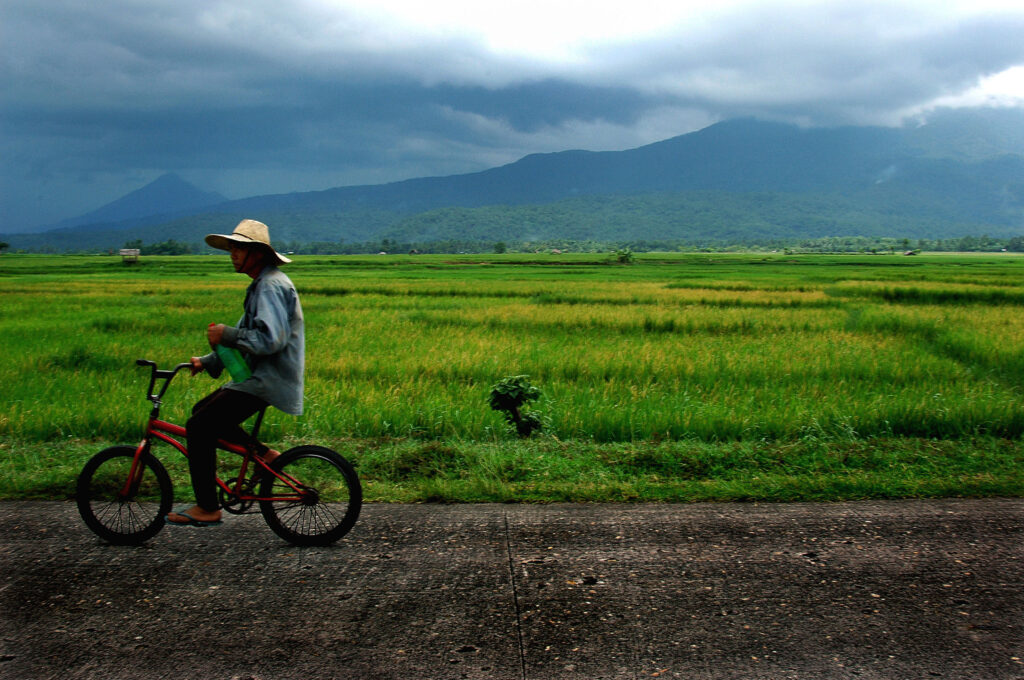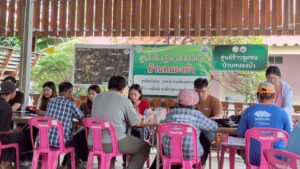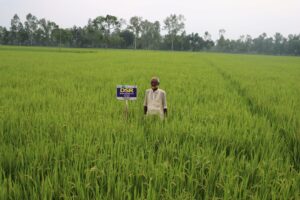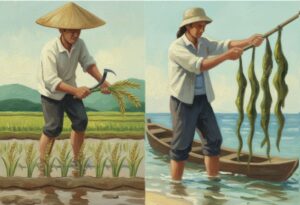By Hom Gartaula, Jon Hellin, Chona Echavez, Jeny Raviz, Susan Bacud, Alice Laborte, Magnolia Rosimo, Rodmyr Datoon, and Julian Gonsalves
Organizations: International Rice Research Institute (IRRI); Research Institute for Mindanao Culture (RIMCU), Xavier University, Ateneo de Cagayan, Philippines; Institute of Weed Science, University of the Philippines Los Banos, Philippines; International Institute of Rural Reconstruction, Cavite, Philippines; Agricultural Systems Institute, University of the Philippines Los Banos, Philippines

Introduction
The agricultural sector in the Philippines stands at the frontline of climate change, where farmers and communities face increasingly severe hazards such as typhoons, floods, droughts, and rising sea levels. These shocks not only threaten productivity and livelihoods but also deepen long standing inequalities tied to gender, age, ethnicity, and poverty. Smallholder farmers, Indigenous Peoples, women, and landless rural workers bear the brunt of climate risks, with limited resources and decision-making power to adapt (Hellin et al., 2022; Petesch et al., 2023).
While national frameworks like the National Climate Change Action Plan (NCCAP) and the country’s Nationally Determined Contributions (NDCs) highlight resilience goals, they often fall short of incorporating the lived realities of marginalized communities. Top-down strategies risk overlooking the knowledge, skills, specific needs, and priorities of those most vulnerable, and identification of the most appropriate climate adaptation pathways.
More recently, scholars and practitioners argue for a transformative adaptation approach—one that goes beyond technocratic, incremental solutions. This approach demands addressing not just biophysical threats but also structural inequities in governance and access (IPCC, 2022). In this context, Participatory Action Learning Strategy (PALS) emerges as a pathway to ensure equity, justice, and sustainability in climate adaptation. Building on the climate resilience projects in the Philippines supported by CGIAR (under the Climate Action Science Program) and ACIAR (under Small Research Activity, SRA), this brief highlights how participatory action learning can be a tool to assess climate risks and offer inclusive solutions so that the outcomes would be more meaningful, equitable, and sustainable. These highlights are drawn from our ongoing work in Guinayangan, Quezon and San Pascual, Batangas in the Philippines.
Framing PALS for climate action
Participatory approaches are widely recognized as crucial for long-term resilience. However, genuine participation goes beyond consultation or tokenism. Fisher (2024) frames this as “participatory parity,” where marginalized perspectives influence not only the process but also the outcomes of adaptation planning. PALS embodies this principle by blending technical expertise with local knowledge, grounding adaptation in lived experiences. It empowers disadvantaged groups to co-identify risks, co-design interventions, and co-produce solutions that reflect both fairness and feasibility. In practice, this means adaptation is not for communities but with them, laying the foundation for shared ownership and sustainability.
At its core, PALS is both a methodology and a governance approach, one that fosters co-learning, empowerment, and iterative adaptation. It integrates five interconnected domains, with equity as a cross-cutting principle:
- Climate risk assessment – Localized, participatory risk mapping (e.g., Climate-Smart Management and Adaption Mapping with Social Equity, or CS-MAP + SE) ensures hazards, vulnerabilities, and exposures are identified not only through technical models but also through farmers’ and women’s lived experiences. This approach values fairness, diverse perceptions, and traditional knowledge.
- Integrating social equity – Equity is seen both as a process (voice, dignity, inclusion) and as an outcome (resource access, fairness). For example, in Guinayangan, equity was relational, while in San Pascual, it was distributive—highlighting the need for multi-pronged and contextual approaches.
- Agroecological resilience – PALS links risk mapping with agroecological practices such as crop diversification, seed banking, and sustainable farming methods. These practices enhance resilience while reflecting gendered adaptations, such as women leading seed banks.
- Community empowerment – Empowerment is both means and an end, and it goes beyond the gender binary of men versus women. Training local leaders, strengthening grassroots organizations, involving men, women, youth and ethnic minorities, and ensuring authentic co-creation allow communities to define their own adaptation pathways.
- Adaptive management – PALS follows an iterative cycle where each stage of reflection, planning, and action informs the next. This feedback loop ensures flexibility, responsiveness, and continued engagement in the face of changing risks.
By operationalizing these domains, PALS becomes more than a participatory technique—it becomes a governance innovation that connects climate resilience with social justice.
The PALS cycle: From vulnerability to action
The design of PALS is grounded in iterative learning cycles that enhance community resilience while foregrounding equity. Drawing from experiences in Guinayangan and San Pascual, the PALS cycle unfolds in five stages (Figure 1).

- Identifying vulnerabilities and inequalities – Communities surface local knowledge on hazards and risks while acknowledging overlapping social inequalities, such as poverty, land tenure issues, and limited service access. This recognition frames adaptation as both a climate and justice issue.
- Co-producing risk maps – Participatory GIS and hazard mapping integrate local and technical expertise. Farmers, fisherfolk, women, and youth collaboratively generate maps that reveal not just hazards but also the socio-spatial patterns of vulnerability.
- Facilitating change and documenting processes – Skilled facilitators mediate discussions, ensuring inclusive participation. Documentation captures evolving practices, conflicts, and negotiations—transforming adaptation into both community practice and academic knowledge.
- Implementing context-specific interventions – Adaptation strategies are grounded in local realities, including agroforestry, crop diversification, water harvesting, and social protection. These interventions combine ecological and social resilience, demonstrating that learning is most powerful when tied to practice.
- Reflecting and scaling – Communities review experiences, assess successes and shortcomings, and refine their strategies. Effective practices, such as trial water-harvesting in Guinayangan or fairness-focused deliberations in San Pascual, can then be scaled and institutionalized into local governance.
This cycle positions adaptation as a continuous process, rather than a one-off project, ensuring sustainability beyond external funding.
Contribution and broader use
The PALS framework makes three key contributions:
- Bridging national and local – It connects national climate policies (e.g., NCCAP, NDCs) with community-defined priorities, ensuring policies resonate with real vulnerabilities and needs of diverse group of people having different capacity to cope with the climate crisis.
- Scaling equity-focused adaptation – By embedding equity as process and outcome, PALS ensures adaptation does not reproduce inequalities but actively addresses them.
- Ensuring sustainability – Its iterative and participatory design allows communities and local governments to sustain adaptation efforts beyond project lifespans.
In Guinayangan and San Pascual, PALS demonstrated that resilience is not achieved by simply deploying technical solutions, but through collective learning, co-creation, and empowerment.
Conclusion
The Philippine agricultural sector illustrates how climate change exacerbates vulnerability and inequality. Incremental adaptation, while important, is insufficient. What is needed is transformative adaptation—one that foregrounds equity, justice, and local agency. By positioning marginalized communities, including women, youth, and ethnic minorities, not as passive recipients but as co-creators, the Participatory Action Learning Strategy (PALS) offers an innovation that is iterative, inclusive, and empowering. It bridges the gap between policy frameworks and lived realities, ensuring that resilience is both climate-smart and socially just. In a world where climate change disproportionately affects the most vulnerable, PALS reminds us that resilience is not just about protecting livelihoods—it is about reshaping systems to be fairer, more inclusive, and more democratic.
References:
Fisher, E. (2024). Participatory parity in climate adaptation planning: Insights from the SE Training Workshop. [Workshop presentation].
Hellin, J., Lundy, M., & Meijer, M. (2022). Climate change, equity, and sustainable food systems: Lessons from smallholder farmers. World Development, 151, 105757. https://doi.org/ 10.1016/j.worlddev.2021.105757
IPCC. (2022). Climate change 2022: Impacts, adaptation and vulnerability. Contribution of Working Group II to the Sixth Assessment Report of the Intergovernmental Panel on Climate Change (IPCC). Cambridge University Press. https://doi.org/10.1017/ 9781009325844
Petesch, P., Bullock, R., Feldman, D., & Badstue, L. (2023). Transformative adaptation for inclusive agrifood systems. Climate and Development, 15(4), 345–359. https://doi.org/10.1080/ 17565529.2022.2127891







